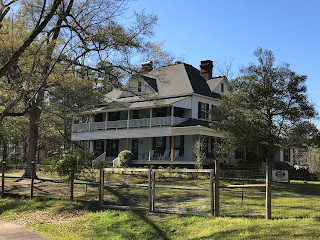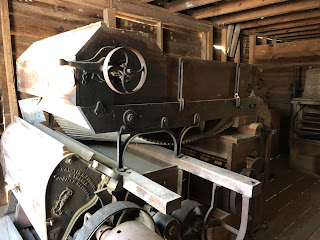You decide: Would we have won the Revolutionary War without these twists of fate?
The American victories at Kings Mountain and Cowpens paved the way to the end of the Revolutionary War at Yorktown. Thomas Jefferson called these battles "the turn of the tide of success."
But for some fateful happenstances, these battles could have easily gone the other way.
So could have our departure from Greenville, SC, when Tim could not swing our RV, the Dawntreader, fully around the U-turn we needed to make, if we were going to visit NPS's National Military Battlefields at Kings Mountain and Cowpens.
With oncoming traffic headed our way, Tim turned into their path until he reached a driveway where we could take refuge. Yikes! There we unhooked our Jeep in preparation for backing out onto the highway once again, a maneuver he successfully made. Whew! I think this twist of fate, the first time we've ever had to unhook the car unexpectedly, subtracted 10 years from my life. But I digress. Back to my question about the Revolutionary War.
The Battle of Kings Mountain, October 7th, 1780
 |
| The obelisk that commemorates the American victory at Kings Mountain |
Forewarned by two Patriot deserters that a large body of militia were marching upon him, British Maj. Patrick Ferguson sent a plea requesting reinforcements to Lord Charles Cornwallis and Lt. Col. Banastre Tarleton holed up in nearby Charlotte, NC. But both Cornwallis and Tarleton were ill, or at least that was their response. Yet, Ferguson was a Scot and as such was not a favorite of either man. Had he been, perhaps his commanding officers would have better supported him and the battle would have turned out differently.
Instead, on October 7, 1780, the Overmountain Men of Col. Isaac Shelby and Col. John Sevier surrounded and swarmed up Kings Mountain where Ferguson and his company were camped.
"When we encounter the enemy, don't wait for a word of command. Let each of you be your own officer, and do the very best you can...If in the woods, shelter yourselves and give them Indian play; advance from tree to tree...killing and disabling all you can..." ~ Col. Isaac Shelby, Patriot leader
 |
| This 1.5 walking trail leads visitors around the battlefield at Kings Mountain. |
Everyone knew Col. Sevier's rugged frontiersmen for their long-rifle marksmanship--and their touchy eagerness for a brawl. But no experienced military man of that day expected men armed only with hunting weapons to be able to face and defeat real soldiers, trained to use the bayonet. It had never happened--until Kings Mountain.
Three times frontiersmen from Tennessee charged up the mountainside. Once, then twice they were chased back down by Carolina Loyalists wielding 17-inch-long bayonets. Yet somehow Sevier's patriots found the courage to stop running, turn around and go back up against that fearsome cold steel one last time.
 |
| The marker where Ferguson fell. |
This time Ferguson was killed and his forces overran. The battle was won!
The Battle of Cowpens, January 17, 1781
Upstate Carolinians drove their cattle down the Blue Ridge Mountains to the cow pens near Chesney, NC where they fattened them up before herding them to market in Charleston, SC. This open forest proved well-suited for the American rebels led by General Daniel Morgan to make a stand against the forces of Lt. Col. Banastre Tarleton at the Battle of Cowpens on January 17, 1781.
Morgan's strategy was to position his rebel sharpshooters at the skirmish line to wait until Tarleton's army moved within shooting distance. Their orders were to aim at the British officers, fire one or two good shots and then fall back to the militia. As the British came within range, the sharpshooters discharged a deadly fire, dropping two-thirds of the officers, before melting back to the second line of the patriots' defense.
"At first it was pop, pop, pop (the sound of the rifles), and then the whole volley. It seemed like one sheet of flame from right to left." ~ Thomas Young, American Militiaman, Fair Forest Regiment, 17 years old
A misunderstood order from Lt. John Eager Howard had the center and left flank of Continental soldiers in retreat only to be urged by General Daniel Morgan to "form, form my brave fellows. Old Morgan was never beaten." When they did so, their new position, perfectly timed, brought them into position to surround the British forces.
 |
| Monument at Cowpens National Battlefield |
This classic military move, a double envelopment by the Americans, the only successful one of the Revolutionary War, brought the battle to a decisive end. For Americans, Cowpens was a surprising victory and a psychological shift in the minds of the Continental soldiers. The British surrendered at Yorktown later that year.
So there you have it! A dysfunctional relationship at Kings Mountain stayed British reinforcements and a misunderstood order led to an unorthodox double envelopment at Cowpens. Moreover, Tim and I concluded our day's trip safely after all, twists of fate in our favor all the way around.


















































